Chameleon Info: "Littlefoot"
Cage Info:
Current Problem - About three weeks ago I noticed two 1 centimeter wide sores on her tail. They were quite deep. It had been about a week and a half since I had handled her. It was a shock and the only possible explanation seemed to be uneaten crickets or roaches gnawing at her tail. In hindsight the moist newspaper at the bottom of her cage where she hung out a lot, should have been a concern. Perhaps it was fungal? Well, she was taken to the vet and her wound was cleaned up, she was given a 30 day antibiotic injection regimen (ceftazidime, 100mg/mL), as well as oral pain med (eloxioral, 1.5mg/mL), and manuka honey twice a day on the wound. They had suggested a radiograph (x-ray) to check for eggs, and a vitamin boost injection that day, which I could not afford.
She has just 2 more injections left, and her sores are almost healed but it seems that below the sores, her tail is shriveling up and dying. She is eating well, and we've observed her drinking from her face. She had been spending time at the bottom of her cage and even sleeping on the floor before her wounds. But she is no longer spending any time on the floor, and is moving more and moving from the window-side of the cage to her sleeping position more in the center of the umbrella plant. She seems like she is doing well, except that she has no use of her tail. Her wounds are about 2 or 3 inches from her butt. Below that, it is brown and seems like it is drying, hard, and slowly shriveling. I'm wondering if I should just be waiting for her tail to fall off? She'll have a very short tail. I worry though that this necrosis would spread up above where it is now. If it falls off and she is fine, and can live longer as an older gal without it, that would be fine.
The other concern with her, perhaps related to these wounds, is that I'm not sure if she's ever laid eggs. She has always had a lay bin and she has never, to my knowledge, dug a tunnel. She has had bouts of lethargy, and spending time at the bottom of her cage, or on top of her lay bin, but then would stop this behavior and go back to hunting and being active and what not. We'd be concerned that she was egg bound, but then her behavior would change. We figured maybe she just liked spending time at the bottom of her cage once in a while. We have read that being eggbound can pinch nerves or cause circulation blockages that can result in tail issues. So it would explain why she wouldn't move to get away from insects nibbling at her (but she would still use her tail to wrap around branches and what not!). I want to get her xrays, but 300-400 dollars is something I can't afford. I do get her plants, and branches, and variety of insects, and her supplements, and lights, and make sure she has an appropriate cage, and everything I can, including taking her to the vet and getting her her meds-- but 300-400 for the xrays was just something I could not afford. I know she's a seasoned lady at 5 years of age, so I'm also not sure if surgery for the removal of the eggs would be a reasonable option or if some kind of birth inducing drug (oxytocin) would be too much for her.
Anyways, thank you for taking the time to read this, and any advice would be greatly appreciated...
P.S. Attached are pictures of the progression of her tail. In some of them, the manuka honey is covering the wounds.

- Your Chameleon - Veiled female, approximately 5 years old, hatched from egg
- Handling - Only when necessary, and a couple times a month to get out of her cage for some free range time
- Feeding - Crickets (4-6 every other day) and Dubia roaches as a staple, gutloaded with Fluker's cricket food and fresh carrot shavings; hornworms (hornworm chow) and silk worms (mulberry leaves) every few months (2, every other day). Also feeding cham various berries as a treat: strawberry, blueberry, raspberry.
- Supplements - Dusting with Zoomed calcium without d3 every feeding. Dusting with Zoomed reptivite with d3 once a month.
- Watering - Misting in the morning with pressurized sprayer for about 1 minute. She drinks from her face. Also dripper refill daily.
- Fecal Description - Solid, moist dark brown poop. White urate. Never tested for parasites
- History - When cham was about 2 years old, lived with a relative for 18 months, then returned living with me. My first post, but I'm a 2nd generation cham dad.
Cage Info:
- Cage Type - Screen, 16"x24"x30"
- Lighting - 24 inch reptisun 5.0 t5. Currently lights on 6am to 8pm. (Pacific Standard Time).
- Temperature - Have not been measuring. We provide a ceramic basking heat emitter, on top of the cage, in a corner. The house, though, stays around 60-70 F. So, chameleon's ambient temp is in that range.
- Humidity - Have not been measuring humidity. We spray daily, and provide the dripper and know live plants are good for humidity. But know that fluctuation in humidity and temperature is something natural in their environment.
- Plants - One schefflera arboricola (umbrella plant). It fills out the cage. Now, two small dracaenas also.
- Placement - In the bedroom, in front of a window looking out (she's always looking out the window, and never spends any time on the front side of the cage). The top of the cage is about 5 feet high.
- Location - Oakland, California, USA
Current Problem - About three weeks ago I noticed two 1 centimeter wide sores on her tail. They were quite deep. It had been about a week and a half since I had handled her. It was a shock and the only possible explanation seemed to be uneaten crickets or roaches gnawing at her tail. In hindsight the moist newspaper at the bottom of her cage where she hung out a lot, should have been a concern. Perhaps it was fungal? Well, she was taken to the vet and her wound was cleaned up, she was given a 30 day antibiotic injection regimen (ceftazidime, 100mg/mL), as well as oral pain med (eloxioral, 1.5mg/mL), and manuka honey twice a day on the wound. They had suggested a radiograph (x-ray) to check for eggs, and a vitamin boost injection that day, which I could not afford.
She has just 2 more injections left, and her sores are almost healed but it seems that below the sores, her tail is shriveling up and dying. She is eating well, and we've observed her drinking from her face. She had been spending time at the bottom of her cage and even sleeping on the floor before her wounds. But she is no longer spending any time on the floor, and is moving more and moving from the window-side of the cage to her sleeping position more in the center of the umbrella plant. She seems like she is doing well, except that she has no use of her tail. Her wounds are about 2 or 3 inches from her butt. Below that, it is brown and seems like it is drying, hard, and slowly shriveling. I'm wondering if I should just be waiting for her tail to fall off? She'll have a very short tail. I worry though that this necrosis would spread up above where it is now. If it falls off and she is fine, and can live longer as an older gal without it, that would be fine.
The other concern with her, perhaps related to these wounds, is that I'm not sure if she's ever laid eggs. She has always had a lay bin and she has never, to my knowledge, dug a tunnel. She has had bouts of lethargy, and spending time at the bottom of her cage, or on top of her lay bin, but then would stop this behavior and go back to hunting and being active and what not. We'd be concerned that she was egg bound, but then her behavior would change. We figured maybe she just liked spending time at the bottom of her cage once in a while. We have read that being eggbound can pinch nerves or cause circulation blockages that can result in tail issues. So it would explain why she wouldn't move to get away from insects nibbling at her (but she would still use her tail to wrap around branches and what not!). I want to get her xrays, but 300-400 dollars is something I can't afford. I do get her plants, and branches, and variety of insects, and her supplements, and lights, and make sure she has an appropriate cage, and everything I can, including taking her to the vet and getting her her meds-- but 300-400 for the xrays was just something I could not afford. I know she's a seasoned lady at 5 years of age, so I'm also not sure if surgery for the removal of the eggs would be a reasonable option or if some kind of birth inducing drug (oxytocin) would be too much for her.
Anyways, thank you for taking the time to read this, and any advice would be greatly appreciated...
P.S. Attached are pictures of the progression of her tail. In some of them, the manuka honey is covering the wounds.
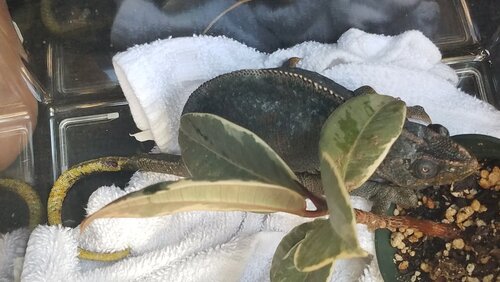
Attachments
-
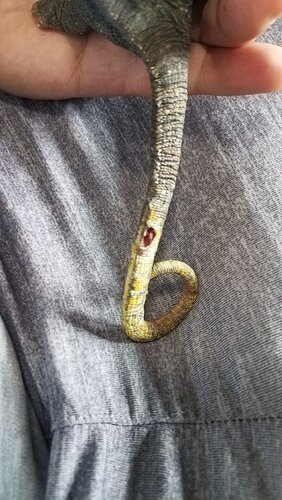 20200425_172200.jpg192.3 KB · Views: 207
20200425_172200.jpg192.3 KB · Views: 207 -
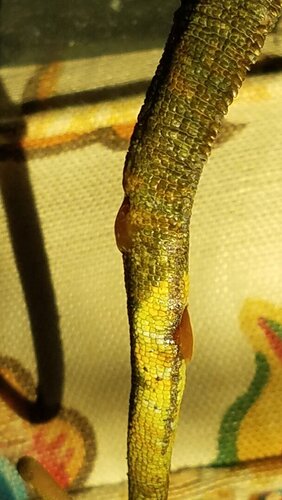 20200427_191018.jpg116.1 KB · Views: 211
20200427_191018.jpg116.1 KB · Views: 211 -
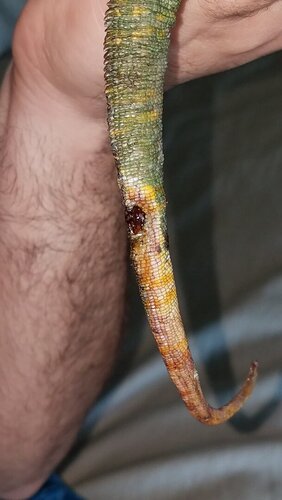 20200510_161455.jpg87.9 KB · Views: 198
20200510_161455.jpg87.9 KB · Views: 198 -
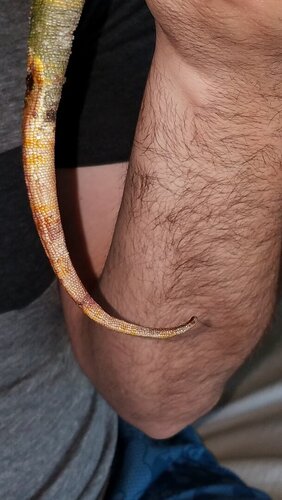 20200510_161517.jpg113.7 KB · Views: 203
20200510_161517.jpg113.7 KB · Views: 203 -
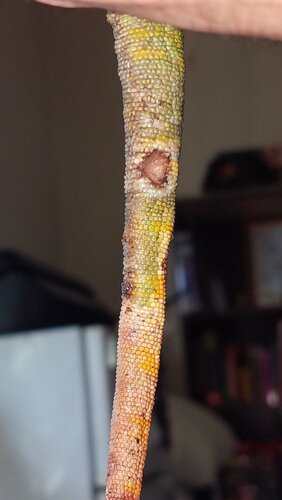 20200510_161628.jpg76.3 KB · Views: 209
20200510_161628.jpg76.3 KB · Views: 209 -
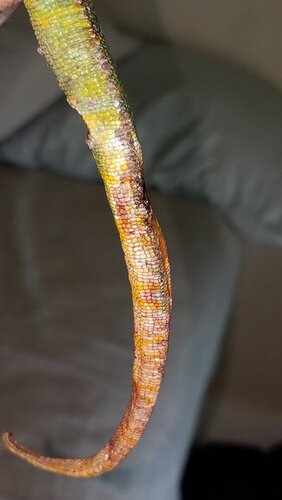 20200510_161702.jpg75.3 KB · Views: 208
20200510_161702.jpg75.3 KB · Views: 208 -
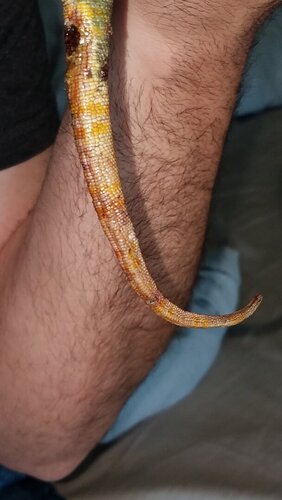 20200510_161806.jpg87.7 KB · Views: 203
20200510_161806.jpg87.7 KB · Views: 203 -
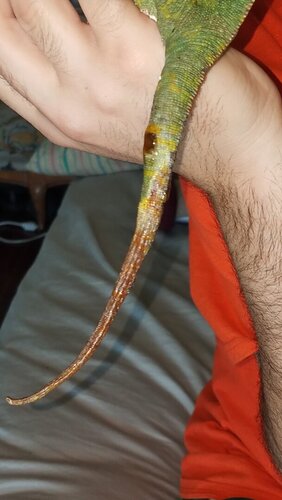 20200517_142330.jpg90.5 KB · Views: 213
20200517_142330.jpg90.5 KB · Views: 213 -
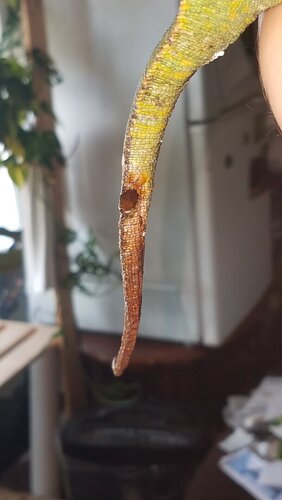 20200517_142346.jpg73.6 KB · Views: 202
20200517_142346.jpg73.6 KB · Views: 202






